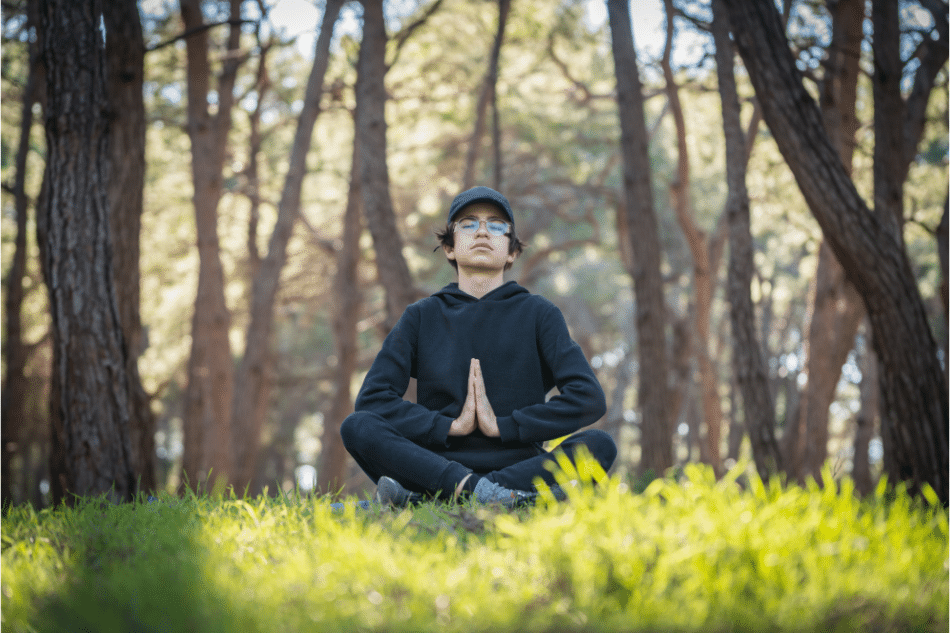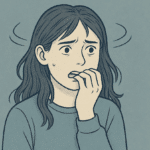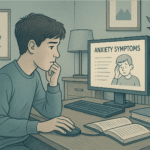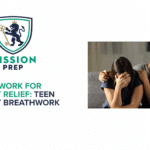Mind-Body Healing: Teen Somatic Experiencing for Anxiety Relief


There’s been a dramatic increase in child and teen anxiety since the COVID-19 pandemic.¹ And while many children recognize that being continuously worried may mean they’re struggling with anxiety, the physical signs often get missed.
Headaches, tight muscles, nausea, or a heavy feeling in the chest. These can all indicate anxiety that has gone beyond the healthy level. Yet, they’ll often be missed.
That’s where the somatic approach to anxiety treatment comes in. Teens can be taught to recognize the body sensations that suggest anxiety. Through somatic experiencing, teens can also develop tools to manage these symptoms, such as through relaxation and stress reduction strategies.
This page will explore:
- The signs of teen anxiety
- A breakdown of somatic experiencing
- How somatic experiencing builds long-term resilience in teens
- Somatic anxiety techniques
- Tips for nervous system regulation in teens
- How Mission Prep can help anxious teens
Recognizing Teen Anxiety
Here are some common (and often overlooked) signs of anxiety in teens:²
Persistent overthinking or difficulty “shutting off” the mind- Trouble sleeping, even when exhausted
- Avoidance of new or challenging situations
- Frequent stomach aches, headaches, or unexplained physical complaints
- Irritability or sudden mood swings
- Heightened sensitivity to criticism or perceived failure
- A need for constant reassurance from friends or family
- Difficulty focusing or following through on tasks
- Restlessness or feeling unable to sit still comfortably
- Perfectionistic tendencies that create pressure or burnout
These signs can often surface as a result of dysregulation in the nervous system. A somatic approach to anxiety treatment can help teens to recognize this dysregulation and respond accordingly.
Somatic Experiencing Explained
When a teen goes through a difficult experience, such as academic pressure or a traumatic event, their body responds. Their muscles may tense up, their breathing may become dysregulated or shallow. Their heart rate will also likely increase. This is a healthy process, but the problem comes when the body isn’t able to process and release this stress. In these instances, it can stay in a hypervigilant state.
Here’s how somatic experiencing can help. It encourages a teen to focus on their body sensations that signal danger. For example, tightness or warmth. By becoming aware of these sensations, the body begins to right itself – automatically bringing the body back to a feeling of safety.
What’s more, the somatic approach to anxiety treatment helps teens to regulate without forcing them to relive any trauma or discomfort. At Mission Prep, we’ve seen how somatic experiencing therapy for teens can be life-changing, especially when combined with other therapeutic support and structured routines.
How Somatic Experiencing Builds Long-Term Resilience in Teens
Somatic experiencing doesn’t just reduce anxiety symptoms. It helps teens build long-term emotional resilience. When young people learn how to regulate their nervous systems, they gain more than just temporary relief. They develop the internal capacity to face stress, uncertainty, and even future trauma with more confidence and less collapse.
This is because trauma-informed somatic work retrains the brain and body to recognize safety. Over time, this reduces hyperarousal and supports a more flexible stress response. Instead of shutting down or spiraling into overwhelm, teens become more capable of returning to a balanced state after challenges.
This resilience is key during adolescence, as it’s a time when emotional intensity is high and the brain is still wiring key emotional circuits. The earlier teens learn somatic regulation, the more deeply it becomes integrated into their future adult coping systems. That’s why nervous system regulation for teens is such a crucial investment in long-term wellbeing.
Somatic Anxiety Techniques
The signs of anxiety in teens aren’t just symptoms. They’re signals from the nervous system. The goal of somatic therapy for youth anxiety is to help teens notice these signals and respond in ways that create safety.
Somatic exercises for anxiety that can help:
- Grounding through the feet: Stand barefoot and slowly shift your weight side to side. Notice the pressure under each foot. Doing so can help build teenage body awareness and connection to the present moment. For instance, studies show that grounding exercises stabilize the autonomic nervous system and regulate heart rate and breathing.⁴
- Orienting the senses: Look around the room and name five things you see, hear, or smell. This helps the brain register that the environment is safe, which is an essential step in somatic stress reduction.⁵
- Vagus nerve breathing: Studies show that deep, slow breathing can significantly reduce anxiety.⁶ For example, diaphragmatic breathing stimulates the vagus nerve and supports nervous system regulation in teens. A simple method includes inhaling for four seconds and exhaling for six.
- Tension-release shaking: Research shows that body vibrations and shaking can reduce anxiety and depression symptoms.⁷ Gentle shaking of the arms or legs helps the body discharge stored energy and is a foundational part of somatic healing for mental health.
- Hand-on-heart calming: Evidence shows that self-soothing touch and being hugged can reduce cortisol levels.¹⁰ Placing one hand on the chest and one on the belly can settle racing thoughts. While doing this, notice warmth, rhythm, or stillness. These subtle cues are often signs that healing is beginning.
Each of these tools are small but powerful. When practiced regularly, they can teach the brain and body how to move out of panic and into steadiness. They’re also accessible – no special equipment or therapy office required.
Tips for Nervous System Regulation in Teens
Nervous system regulation isn’t just for moments of stress. It’s something that can be built slowly, through consistent habits that tell the body it’s safe. By weaving in daily routines that support mind-body balance, teens can increase their capacity to handle anxiety before it even shows up.
Here are proactive strategies that support somatic healing for mental health and reduce the chance of emotional overwhelm:
- Establish routines: Research shows that healthy sleep routines and high-quality sleep are linked to higher levels of wellbeing.⁸ Therefore, regular sleep and meal times can support circadian rhythm and soothe the nervous system.
- Daily movement: Studies show that exercise is linked to reduced anxiety.⁹ Gentle aerobic activity (like walking, dancing, or yoga) helps metabolize stress hormones and supports somatic stress reduction by giving the body a safe outlet for activation.
- Body scanning and check-ins: Body scanning is shown to be effective in reducing anxiety.¹¹ Teaching teens to notice subtle shifts like tight shoulders and shallow breath helps them intervene early. This builds teenage body awareness and supports emotional literacy.
- Tech boundaries: One study has found that people who take a one-week digital detox experience improved mental wellbeing.¹² Short, scheduled breaks from screens allow the body to reset and rebalance.
- Nature exposure: Research shows that walking in nature can improve mental health and positively impact anxiety and depression.¹³ Time in green spaces has measurable effects on heart rate and cortisol levels, both indicators of nervous system health.
- Nourishment and hydration: Balanced blood sugar and adequate hydration reduce physiological anxiety signals that the brain might otherwise misread as emotional threat.¹⁴
These somatic tools for teens don’t just help them feel better in the moment, they support long-term nervous system regulation and build the foundation for a more resilient, connected life.

Reach Out to Mission Prep for Assistance with Body Based Anxiety Relief
When anxiety shows up in the body, talking alone isn’t always enough. At Mission Prep, we understand how deeply emotions can live in the nervous system and how powerful somatic tools can be in helping teens feel safe, grounded, and in control.
Our therapists are trained in trauma-informed somatic work, combining evidence-based methods with body-based anxiety relief techniques to support real, lasting change. Whether your teen struggles with tension, emotional reactivity, or a nervous system that’s always “on,” we offer somatic therapy for youth anxiety that meets them where they are.
You don’t have to figure this out alone. Reach out to learn how somatic experiencing therapy for teens can help your child reconnect with their body, regulate emotions, and rediscover a sense of calm from the inside out.
FAQs
Is Somatic Experiencing Therapy Safe for All Teens?
Yes, when practiced by a qualified clinician, somatic experiencing is considered a very safe approach. The work is gentle. Teens aren’t asked to talk through painful memories or rehash trauma. Instead, they’re guided to notice small physical cues, like breath, muscle tension, or heartbeat, and learn to respond to these signals with curiosity and care. Somatic therapy for youth anxiety is intentionally paced and always centers the teen’s comfort level. It’s less about pushing through and more about listening to what the body needs to feel steady again.
Can This Somatic Approach to Anxiety Treatment Help Teens Who Don’t Want to Talk?
Yes, and in fact, that’s often where it shines. Some teens find it hard to explain what’s going on, or they simply shut down in traditional talk therapy. A somatic approach meets them differently. It starts with the body, not conversation. Through gentle awareness of physical sensations – like tightness, breath, or posture – teens can begin to feel better without needing to put everything into words.
What If My Teen Has High-Functioning Anxiety or Hides Their Symptoms?
Somatic anxiety techniques are especially useful for teens who have high-functioning anxiety and appear “fine” on the outside but carry stress in their bodies. These techniques uncover hidden tension and help teens develop healthier coping strategies through teenage body awareness therapy.
How Quickly Do Teens Benefit from Body-Based Anxiety Relief?
Some teens feel more grounded after just a few sessions, while others take longer. Somatic exercises for anxiety, when practiced regularly, can lead to real changes in how a teen’s nervous system responds to stress. It’s a gradual shift, but a powerful one.
Can Somatic Therapy Be Combined with Other Mental Health Support?
Yes. Many families choose to combine somatic experiencing with talk therapy, mindfulness, or academic coaching. It also enhances outcomes by supporting nervous system regulation in teens while addressing cognitive and emotional growth.
References
- Fortuna, L. R., Brown, I. C., Lewis Woods, G. G., & Porche, M. V. (2023). The impact of COVID-19 on anxiety disorders in youth: Coping with stress, worry, and recovering from a pandemic. Child and Adolescent Psychiatric Clinics of North America, 32(3), 531–542. https://pmc.ncbi.nlm.nih.gov/articles/PMC9894765/
- Chand, S. P., & Marwaha, R. (2025). Anxiety. In StatPearls. StatPearls Publishing. https://www.ncbi.nlm.nih.gov/books/NBK470361/
- Kuhfuß, M., Maldei, T., Hetmanek, A., & Baumann, N. (2021). Somatic experiencing—Effectiveness and key factors of a body-oriented trauma therapy: A scoping literature review. European Journal of Psychotraumatology, 12(1), 1929023. https://pmc.ncbi.nlm.nih.gov/articles/PMC8276649/
- Koniver, L. (2023). Practical applications of grounding to support health. Biomedical Journal, 46(1), 41–47. https://pmc.ncbi.nlm.nih.gov/articles/PMC10105020/
- Rochester.edu. Retrieved July 11, 2025. 5-4-3-2-1 coping technique for anxiety. https://www.urmc.rochester.edu/behavioral-health-partners/bhp-blog/april-2018/5-4-3-2-1-coping-technique-for-anxiety
- Bentley, T. G. K., D’Andrea-Penna, G., Rakic, M., Arce, N., LaFaille, M., Berman, R., Cooley, K., & Sprimont, P. (2023). Breathing practices for stress and anxiety reduction: Conceptual framework of implementation guidelines based on a systematic review of the published literature. Brain Sciences, 13(12), 1612. https://pmc.ncbi.nlm.nih.gov/articles/PMC10741869/
- Chawla, G., Azharuddin, M., Ahmad, I., & Hussain, M. E. (2022). Effect of whole-body vibration on depression, anxiety, stress, and quality of life in college students: A randomized controlled trial. Oman Medical Journal, 37(4), e408. https://pmc.ncbi.nlm.nih.gov/articles/PMC9396709/
- Prokeš, M. (2023). Sleep quality and sleep routines as mediators of stressors and life satisfaction in Czech university students: A structural equation model. Frontiers in Psychology, 14, 1231773. https://www.frontiersin.org/journals/psychology/articles/10.3389/fpsyg.2023.1231773/full
- Anderson, E., & Shivakumar, G. (2013). Effects of exercise and physical activity on anxiety. Frontiers in Psychiatry, 4, 27. https://pmc.ncbi.nlm.nih.gov/articles/PMC3632802/
- Dreisoerner, A., Junker, N. M., Schlotz, W., Heimrich, J., Bloemeke, S., Ditzen, B., & van Dick, R. (2021). Self-soothing touch and being hugged reduce cortisol responses to stress: A randomized controlled trial on stress, physical touch, and social identity. Comprehensive Psychoneuroendocrinology, 8, 100091. https://pubmed.ncbi.nlm.nih.gov/35757667/
- Kogan, L. R., & Bussolari, C. (2021). Exploring the potential impact of a virtual body scan meditation exercise conducted with pet dogs on recipients and facilitators. Frontiers in Psychology, 12, 698075. https://www.frontiersin.org/journals/psychology/articles/10.3389/fpsyg.2021.698075/full
- Alanzi, T. M., Arif, W., Aqeeli, R., Alnafisi, A., Qumosani, T., Alreshidi, A., Alhawsawi, S., Alnakli, R., Alotaibi, A., AlOthman, M., Khamisi, M., & Alanzi, N. (2024). Examining the impact of digital detox interventions on anxiety and depression levels among young adults. Cureus, 16(12), e75625. https://pmc.ncbi.nlm.nih.gov/articles/PMC11725043/
- Grassini, S. (2022). A systematic review and meta-analysis of nature walk as an intervention for anxiety and depression. Journal of Clinical Medicine, 11(6), 1731. https://pmc.ncbi.nlm.nih.gov/articles/PMC8953618/
- Aucoin, M., LaChance, L., Naidoo, U., Remy, D., Shekdar, T., Sayar, N., Cardozo, V., Rawana, T., Chan, I., & Cooley, K. (2021). Diet and anxiety: A scoping review. Nutrients, 13(12), 4418. https://pmc.ncbi.nlm.nih.gov/articles/PMC8706568/



















